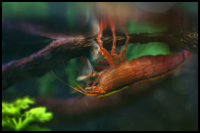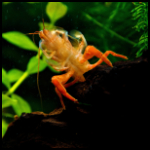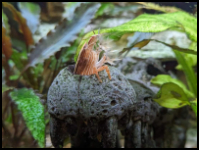





Quick Care Details (Table)
| Livestock Characteristics | Value |
|---|---|
| Care Level | Moderate |
| Temperament | Peaceful |
| Diet | Omnivore |
| Maximum Size | 3 Inches |
| Minimum Tank Size | 10 Gallons |
| Plant Safe | Yes |
| Temperature Range | 72-82°F |
| PH Range | 6.5-7.5 |
| KH Range | 3-8 dKH |
| GH Range | 4-10 dGH |
Species Specific Categories
Helpful Video
Care Details
Aquascape: Imagine your Bamboo Shrimp exploring a jungle-like aquarium. Create a comfy home with plenty of broad-leaved plants or moss for them to sit on while they filter-feed. Add driftwood or rocks for them to perch on and grab food from.
Substrate: Think soft sands or fine gravel for your Bamboo Shrimp's home. They'll love sifting through these materials, searching for their tiny meals without hurting their delicate feeding arms.
Disease Prevention: Keeping their water clean is like giving them a cozy, healthy home. Regular water changes, cleaning routines, and not overfeeding them keep diseases at bay. If you're adding new tank buddies, it's like introducing new friends—quarantine them first to avoid any unwanted surprises!
Filtration: Your Bamboo Shrimp prefer a gentle flow—think of it as a calm river rather than a raging torrent. Filters like sponge or pre-filters work great, cleaning the water without causing a storm.
Lighting: Picture a soft, cozy ambiance for your shrimp friends. Moderate lighting keeps them comfortable without overwhelming their space.
Water Flow: They're like tiny detectives looking for clues in the water. They prefer a moderate flow—just enough to carry their dinner past their feeding spot.
Hardiness: They're sturdy little beings when things stay consistent. But like us, sudden changes can throw them off. Keep an eye on their water conditions to make sure they're comfy.
Acclimation: Introducing them to a new tank is like welcoming someone to your home. Take it slow, let them get used to the new place by gradually mixing their water with the tank water.
Special Requirements: Your Bamboo Shrimp need a cozy spot to perch and access to surfaces to feed on. Remember to sprinkle in some specialized food for filter feeders, so they can enjoy their meals in style.
Temperament and Behavior
Behavior: Bamboo Shrimp are peaceful filter feeders known for their distinct appearance with long, feathery arms. They spend their time perched on surfaces, using their specialized fan-like appendages to filter particles from the water. These shrimp are quite gentle and spend much of their day slowly filtering and foraging for food.
Breeding: Breeding Bamboo Shrimp in captivity is challenging. They have complex larval stages requiring brackish water conditions, making successful breeding uncommon in home aquariums.
Aggression: Bamboo Shrimp are non-aggressive and interact peacefully with other tank inhabitants. They pose no threat to fish or other shrimp species.
Tankmates Compatibility: These shrimp are compatible with peaceful community fish and other non-aggressive shrimp species. However, avoid housing them with large or aggressive fish that might mistake their long feeding arms for food.
Activity Level: Bamboo Shrimp are moderately active during feeding times but generally move at a slow, deliberate pace. Their filter-feeding behavior keeps them occupied, mainly in areas with moderate water flow.
Schooling or Shoaling Behavior: While Bamboo Shrimp don't exhibit schooling behavior, they can be kept in groups without issues. However, they tend to focus on their individual feeding areas rather than forming social groups.
Plant Compatibility: They're compatible with most aquatic plants and might even climb on leaves to filter-feed. Healthy plants provide them with additional surfaces to forage on and contribute to maintaining water quality.
Diet and Nutrition
Dry Foods: Think of dry foods as snacks for your Bamboo Shrimp. They might nibble on tiny particles like fish flakes or pellets that drift around in the water. While they might grab a bite, these foods won't fully satisfy their hunger.
Frozen Foods: Frozen foods are like a more substantial meal. Imagine them enjoying some frozen delights like brine shrimp or bloodworms. These provide more nutrition and are closer to what they'd eat in the wild.
Live Foods: Live foods are like a gourmet feast for your Bamboo Shrimp! They absolutely love tiny organisms like microalgae or infusoria. It's like a buffet of natural goodness that keeps them happy and healthy.
Vegetables: For Bamboo Shrimp, veggies are like a healthy treat! Imagine offering them blanched vegetables like zucchini or spinach. It's a nutritious option that adds variety to their diet.
Algae: Algae is like their natural salad bar! Bamboo Shrimp love to graze on the microscopic algae that grow in the tank. It's a bit like having their favorite snack always available.
Feeding Schedule: Think of feeding them a little bit every day or every other day, like snack time or mealtime for us. Offering a variety of foods—both dry and frozen, along with algae and veggies—gives them a balanced diet.
Supplemental Foods: Supplements are like the vitamins we take—they give a little extra boost! Specialized foods for filter feeders or powdered foods with nutrients can ensure they get all the necessary vitamins and minerals.
Tank Parameters
Tank Size: Imagine giving your Bamboo Shrimp a roomy home, like a cozy apartment. A tank around 10 gallons or larger is perfect. It gives them space to roam around and find their favorite spots.
Tank Length and Measurements: Think of a tank that's about 20 inches long, 10 inches wide, and 12 inches tall—this gives them enough room to wander and explore their aquatic world.
Water Temperature: Keep their water comfy, like a pleasant bath temperature, around 72°F to 82°F (22°C to 28°C). It's like making sure their home is just the right warmth for a relaxing soak.
pH (Acidity/Alkalinity): Picture a balanced environment, like water that feels just right. Aim for a pH between 6.5 to 7.5—this range ensures a comfortable and stable environment for your shrimp friends.
KH (Carbonate Hardness) and GH (General Hardness): These levels are like minerals in water, providing the right balance. Aim for a carbonate hardness (KH) between 2 to 6 and a general hardness (GH) between 6 to 12. It's like ensuring the water feels familiar and comfortable for your Bamboo Shrimp.
Hardiness: Bamboo Shrimp are quite resilient, but like us, they prefer consistency. Keeping water conditions stable helps them feel at ease and healthy.
Nitrate (NO3) Levels: Imagine keeping their home fresh and clean. Aim to keep nitrate levels below 20 ppm (parts per million). It's like ensuring the air quality in a room is nice and pure.
History, Popularity, History and Species Variety Details
The History, Popularity and Habitat
History: So, the Bamboo Shrimp originates from Southeast Asia, chilling in freshwater rivers and streams. They've got this cool thing going on with their long, feathery arms, using them to snag tiny bits of food from the water. Over time, folks in the aquarium hobby took a liking to them.
Popularity: You know how some things just catch on? That's what happened with Bamboo Shrimp. Their funky way of filtering particles from the water using their arms impressed aquarium fans. They became a hit, like that cool new gadget everyone wants to get their hands on.
Habitat: Back in their home turf, these shrimp hang out in freshwater spots with gentle currents. They grab onto rocks or driftwood, doing their thing—filtering food from the water. In tanks, keeping things like gentle water flow and surfaces for perching and feeding makes them feel right at home.
Bamboo Shrimp have this interesting backstory, and aquarium enthusiasts dig their unique vibe. Creating a comfy setup similar to their natural habitat helps them thrive and enjoy their aquatic life.
Back to top
Similar Shrimp Types
Vampire Shrimp (Atya gabonensis):
- Shares the long, feathery arms for filter feeding.
- Similar care requirements, enjoying slow to moderate water flow.
- Its peaceful nature and striking appearance make it a popular choice.
Common Tank mates that you can keep with them
- Small Peaceful Fish:
- Rasboras: Such as Harlequin Rasboras or Chili Rasboras.
- Small Tetras: Like Neon Tetras or Ember Tetras.
- Dwarf Corydoras: Such as Pygmy Corydoras.
- Guppies: Peaceful and colorful.
- Bottom Dwellers:
- Dwarf Otocinclus: Algae-eating and peaceful.
- Small Plecos: Like Bristlenose Plecos or Clown Plecos (ensure adequate space).
- Shrimp and Snail Species:
- Other Shrimp: Such as Cherry Shrimp or Amano Shrimp (keep an eye on available space and competition for food).
- Snails: Peaceful species like Nerite Snails or Malaysian Trumpet Snails.

